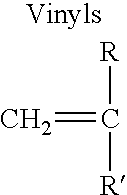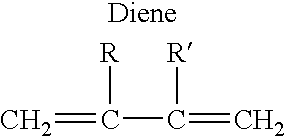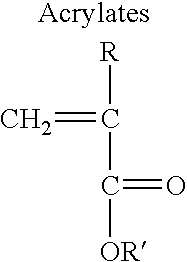Amphiphilic core-shell latexes
a technology of amphiphilic core shell and latex, which is applied in the direction of coatings, etc., can solve the problems of high oxidative conditions, low surface incorporation and formation of a large amount of water-soluble polymers, and complicated deposition procedures
- Summary
- Abstract
- Description
- Claims
- Application Information
AI Technical Summary
Problems solved by technology
Method used
Image
Examples
Embodiment Construction
In a preferred process, radicals are first generated on the nitrogen atoms of the hydrophilic polymer through interaction with alkyl hydroperoxide or by other means, and then initiate the free-radical polymerisation of vinylic monomer. The hydrophobic side chains of vinylic polymer generated during the reaction phase separate to form latexes of monodisperse core-shell particles with the hydrophobic polymer as the core and the hydrophilic polymer as the shell.
For example, poly(ethyleneimine) (PEI) is a commercially available water-soluble polymer. It contains 25% primary, 50% secondary and 25% tertiary amino groups. It was discovered that the graft copolymerisation of methyl methacrylate (MMA) onto PEI could be readily achieved in water in the presence of a trace amount of an alkyl hydroperoxide (ROOH) at 80.degree. C. A nearly quantitative conversion of MMA is obtained in 2 h, giving a stable white emulsion with mean particle sizes ranging from 120 to 135 nm (diameter) and a very na...
PUM
| Property | Measurement | Unit |
|---|---|---|
| weight % | aaaaa | aaaaa |
| number average diameter | aaaaa | aaaaa |
| polydispersity | aaaaa | aaaaa |
Abstract
Description
Claims
Application Information
 Login to View More
Login to View More - R&D
- Intellectual Property
- Life Sciences
- Materials
- Tech Scout
- Unparalleled Data Quality
- Higher Quality Content
- 60% Fewer Hallucinations
Browse by: Latest US Patents, China's latest patents, Technical Efficacy Thesaurus, Application Domain, Technology Topic, Popular Technical Reports.
© 2025 PatSnap. All rights reserved.Legal|Privacy policy|Modern Slavery Act Transparency Statement|Sitemap|About US| Contact US: help@patsnap.com



